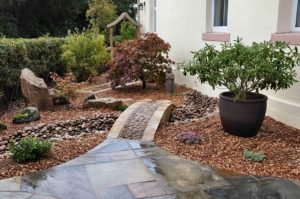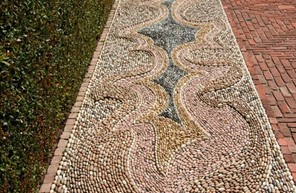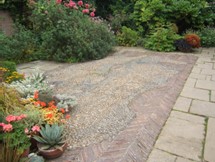Home hardening and wildfire safety can take many forms. In fact, even garden landscapes can be designed with wildfire safety in mind. With wildfire safe landscape mitigation playing an everyday role in what we do at Wildfire Partners, we’ve put together a guide of landscaping recommendations and best practices for your spring re-fresh.
Whether you’re starting a landscape design from scratch, or you’re sprucing up an already existing landscape for spring, these design tips are for you!
Ready to spring ahead with wildfire safe landscaping?
Spring Landscaping First Steps
As spring creeps up, it’s always best to get ahead on landscape design by getting familiar with the landscape you’ll be working with. Consider the conditions your space is exposed to.
These can include:
- Light
- Wind
- Landscape contours for water catchment or drainage
- And more
Taking these conditions into account will help you determine whether you’ll need to prioritize key details like moisture retention with adequate mulching or planting low light tolerant plant varieties for a shaded area. As soon as the ground is soft enough and nightly frosts subside its safe for you to start implementing your design by working the ground!
Wildfire Safe Materials and Best Practices
Now that you’ve considered your landscape, take a look at these wildfire safe materials and best practices to make your landscape part of your robust wildfire mitigation!
Wildfire Safe Materials
The use of non-combustible materials in a landscape design can break up the travel pathway for active fire or embers, preventing your plants and landscaping materials from becoming fuels in a wildfire emergency. For a hardy wildfire resilient landscape, always avoid wood mulch within 15 feet of the home, and be thoughtful about the positioning of your flowers, shrubs, and trees. These materials are best:
- Stone Ground Cover: Decorative rocks, stone, pea gravel, or squeegee mulch works great as ground cover in your landscape to break up fire travel.
- Non-combustible Fencing and Boundaries: Non-combustible materials like metal, stone, masonry blocking, or concrete fencing can be used as non-combustible landscape boundaries.
- Wildfire Safe Patio Materials: For a decking alternative, create a non-combustible patio with concrete, flagstone, or pavers. A patio is a safer alternative to a highly combustible wooden deck on the exterior of your home.
All of these materials are key to creating a resilient and wildfire safe landscape design around the exterior of your home. Here are some photos for reference!


Stone and Pea Gravel Ground Cover Non-combustible Boundaries

Concrete Fencing
Design Practices and Patterns
As you implement your landscape design, it’s important to follow wildfire safe practices to maintain a defensible space around the exterior of your home. Here are some best practices to be aware of during the process:
- Planting Islands (Horizontal Separation): Planting in groups or islands can help break up pathways for fire or ember travel. After planting in islands, add in stone or pea gravel ground cover for non-combustible mulching around your plants.
- Separate Plants Vertically:
- Pots and Planters: Gardening with planters or raised beds is a great way to safely enjoy your favorite plants and edibles near the exterior of your home. This wildfire safe practice also allows potted plants to be easily moved if necessary. To safely incorporate this practice into your garden landscape, try composite concrete pots, or raised metal garden beds.
- Stone Mosaics: If you’re hesitant to include plants into your landscape design, stones can be used to create mosaics as a design alternative. Take a look at the examples below!
- Low Growing Plants: When planning your landscape, make sure that any plants closer to the home maintain a height of less than 1 foot. As you move farther away from the exterior, plant heights can increase, but anything within a few feet should be low growing to limit ladder fuels.


Non-combustible Planters Stone Mosaic Landscape Design


Stone Mosaic Landscape Design Planting Islands (Horizontal Separation)
Follow Along for More Tips & Tricks
Preparing your landscape for the warm season can be a blast! And by incorporating wildfire safe designs, you can feel confident that your landscape is defensible against wildfire emergencies. To follow along for more wildfire safety tips, event information, and community outreach, join our newsletter here, or check out our blog page for more helpful information!
Additionally, if you’re interested in learning more about wildfire smart horticulture and plants, check out the Northern Water landscaping templates here, or take a look at this CSU Extension Fact Sheet for information on Low-Flammability Landscape Plants!


Comments are closed.